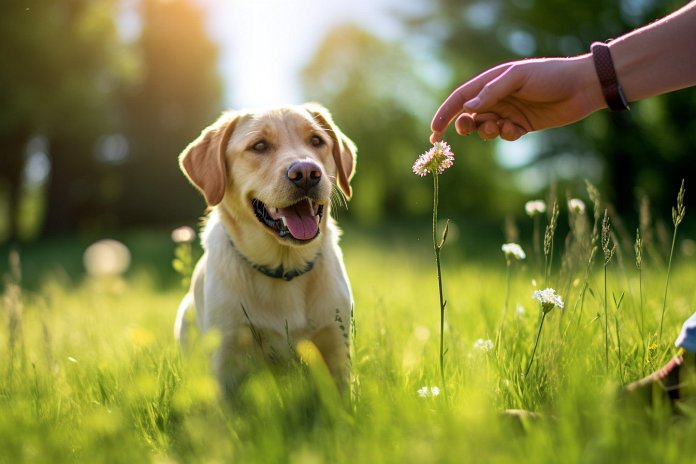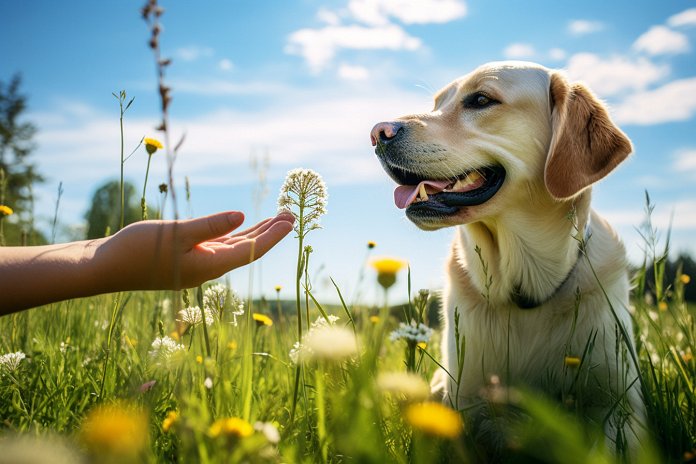
Inside your dog’s nose are up to 300 million olfactory receptors, which help dogs (and humans) sniff various odors and smells.
Dogs have an incredible sense of smell
, capable of detecting certain odors in parts per billion. But how powerful is this sense of smell? Can dogs actually smell hormones in humans? Read on to find out!
Signs Your Dog Can Smell Human Hormones
Dogs are highly attuned to their environment and their humans. They can sense changes in our behavior and also detect changes in our bodies. In fact, dogs can sense changes in blood sugar levels, epileptic fits, narcolepsy, allergic reactions, and many other sensations. Due to this ability, dogs are now being trained as medical detection “assistants” to alert their handlers to a medical crisis before it happens.
Like humans, dogs also exhibit changes in behavior when they smell something unusual. By observing your dog’s behaviors, you can identify signs that your dog detects a hormonal change. For example, your dog may raise its nose and tilt its head to concentrate on sounds and smells in the environment. It may also be relaxed and alert, or show a busy sniffer and a high, non-wagging tail when intrigued by a new scent.
When humans experience fear, anger, or sadness, our bodies may produce certain hormones, such as adrenaline. Dogs can smell scents from these hormones and other chemicals released in our bodies. However, be aware of any uncharacteristic behavior in your dog, as unfamiliar smells and changes in the environment may distress them. Increased vocalization, agitation, or stress could indicate something is off.
Body Language
Signs that your dog senses a hormonal change may include growling, being alert, barking, head tilting, whining, a raised tail, and ears up. Other signs may include agitation, extra affection, guarding the owner, and being extra protective.
The History Behind Dogs Smelling Human Hormones
Through domestication, dogs have become integrated into our households and are now considered true family members. This close relationship allows dogs to be more sensitive to changes in their environment, human behaviors, and changes in human body chemistry.
Dogs are astute animals that can observe what’s happening around them. They can often sense when we are feeling stressed. Dogs are familiar with our habitual movements, expressions, and body language. Hormonal changes are often accompanied by behavioral, emotional, and physical changes, providing dogs with additional hints that something may be off.
The Science Behind Dogs Smelling Human Hormones
Humans have about 6 million olfactory receptors in their noses, allowing them to recognize thousands of smells. Dogs, on the other hand, have up to 300 million olfactory receptors, giving them a powerful sense of smell. Additionally, dogs have a brain section dedicated to analyzing smells that is about 40 times larger than in humans. This makes a dog’s sense of smell 10,000 to 100,000 times sharper than ours.
Veterinarians and animal behaviorists agree that dogs can detect changes in human hormones at a subconscious level. Dogs are highly perceptive and quickly pick up on changes in human behavior. They may attribute these changes to hormonal fluctuations in our bodies. However, researchers have yet to fully understand exactly what chemical compounds and changes dogs can sense.
Training Your Dog to Smell Hormones
A dog’s ability to smell human hormones is either present naturally or not at all. Training them to smell hormones is not as simple as following a training handbook, as experts are still studying dogs’ sense of smell. However, you can train your dog to remain calm and focused under pressure, with the help of professionals such as research organizations or animal behaviorists.
In conclusion, dogs are incredible creatures with the ability to sense human hormones. Although there is still much to discover and understand, dogs’ sense of smell has the potential to save lives in the future. But one thing is for certain: dogs deserve our love and appreciation.
“Dogs’ incredible sense of smell allows them to detect changes in human hormones – a skill that can be trained and used to save lives.”

Tips & Things to Know
1️⃣ Dogs have an incredible sense of smell, with up to 300 million olfactory receptors in their noses. This allows them to detect changes in human hormones and other chemicals released by our bodies.
2️⃣ Signs that your dog can smell a hormonal change include raised nose and tilted head, relaxed and alert behavior, busy sniffer, and a tail held high and not wagging. Uncharacteristic behavior such as vocalization, agitation, or stress may also indicate a hormonal change.
3️⃣ Dogs’ ability to smell human hormones is a natural and innate ability that cannot be trained easily. However, you can train your dog to remain calm and focused under pressure, which may help them in detecting and responding to hormonal changes. Consulting with a research organization or animal behaviorist can provide professional guidance in this training process.
Frequently Asked Questions, Answered ✅
1. How powerful is a dog’s sense of smell?
Answer: Dogs have a sense of smell that is 10,000 to 100,000 times sharper than humans.
2. Can dogs smell human hormones?
Answer: Yes, dogs have the ability to detect changes in human hormones at a subconscious level.
3. What are some signs that a dog can smell hormonal changes?
Answer: Signs may include raised nose and tilted head, relaxed and alert behavior, busy sniffer and a tail held high, vocalization, agitation, and changes in body language.
4. Why are dogs able to smell human hormones?
Answer: Dogs have up to 300 million olfactory receptors, a part of their brain dedicated to analyzing smells, and are highly perceptive to human behavior, allowing them to detect changes in human hormones.
5. Can dogs be trained to smell human hormones?
Answer: The ability to smell human hormones is innate in some dogs, but training them to identify and recognize these changes accurately is still being studied. Professional help from research organizations or animal behaviorists may be needed for training.